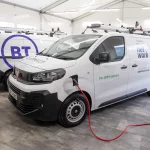O2 Deploys 150th 4G Mobile Site Under UK Shared Rural Network

Mobile network operator O2 (VMO2) has today revealed that they’ve now rolled out enhanced 4G (mobile broadband) coverage across 150 rural sites (up from 100 in mid-Feb 2024) as part of their commitment under the £1bn Shared Rural Network (SRN) project, which aims to extend geographic 4G cover (aggregate) to 95% of the UK by the end of 2025.
The industry-led SRN – supported by £500m of public funding and £532m from operators – involves both the reciprocal sharing of existing masts in certain areas and the demand-led building and sharing of new masts in others between the mobile operators. But the 95% figure is only when the service is available from at least one operator, while the UK coverage forecast for SRN completion for all operators is actually just 84% for the same date (i.e. geographic areas where you’ll be able to take 4G from all providers).
The remote Scottish Inner Hebrides Isle of Eigg, which is home to less than 100 people, has become the home of Virgin Media O2’s 150th SRN site (mast) – some 117 of those are in rural parts of Scotland. While these 150 sites are controlled by O2, customers of Three UK and Vodafone are also benefitting from the operator’s rollout as part of shared access (EE didn’t take part in this aspect of the SRN).
Advertisement
O2 needed to use boats, helicopters and off-road vehicles to install a new 4G mast on the island, which previously only had coverage from just one provider, thus the upgrade offers residents more choice and will help many visitors stay connected for the first time.
Taking into account progress from all operators and the related infrastructure sharing agreements, VMO2’s customers can now benefit from faster 4G services at more than 200 rural locations.
Jeanie York, CTO at Virgin Media O2, said:
“We are continuing our Shared Rural Network rollout at pace to ensure more rural communities can access reliable mobile connectivity. Having delivered more sites than any other operator, our commitment to delivering this ambitious programme and levelling up rural areas is clear.
The 150 sites we have delivered will enable more residents, businesses and visitors in rural areas to benefit from better mobile coverage, with dozens more locations set to go live in the coming weeks. This work is vital in tackling the urban-rural digital divide that exists in the UK.”
Julia Lopez, Minister of state for Data and Digital Infrastructure, said:
“Backed by government funding, Virgin Media O2’s rapid rollout of the Shared Rural Network is delivering better 4G coverage to rural communities across the UK. The completion of its 150th mast in the Isle of Eigg in Scotland involved the use of helicopters, boats and off-road vehicles to get the build done and shows the UK Government’s commitment to rural residents and businesses, so the British public can enjoy good connectivity wherever they live.”
Despite the progress, the National Audit Office (NAO) recently confirmed (here) that Three UK, Vodafone and O2 were “each likely to miss their Ofcom licence obligation to provide 88% 4G coverage by June 2024” (i.e. the target for partial notspots (PNS) and had requested to “discuss an 18-month extension to the PNS element of the programme” (EE has already completed this target). At present, this only impacts the PNS, not the main target for Total Not-Spot (TNS) areas by early 2027.
Just to recap. Ofcom’s licence obligations commit each individual operator to increase its 4G coverage to 88% of the UK’s landmass by June 2024 – rising to 90% by January 2027 – with these individual obligations supporting the overall target of 95% by December 2025.
Advertisement
Last month saw the government reject calls for a delay to the PNS target (here), albeit partly because this is something that Ofcom first need to assess (they’re expected to reach a conclusion during the autumn). The government claims that the final TNS coverage target could still be achieved on time (i.e. they’ve build a fair bit of allowance for possible delays into the programme), even if there’s a delay to the PNS side.
Mark is a professional technology writer, IT consultant and computer engineer from Dorset (England), he also founded ISPreview in 1999 and enjoys analysing the latest telecoms and broadband developments. Find me on X (Twitter), Mastodon, Facebook, BlueSky, Threads.net and Linkedin.
« CityFibre Complete Primary FTTP Broadband Rollout in Kettering























































Three really need to pull their finger out when it comes to rural coverage.
I was in the peak district the other week and once again Three gives full bars but nothing loads because they have decided to deploy band 20 only. Making matters worse, in preperation for the 3g Switch off, you stick to 4G now so everyone is fighting over 5mhz instead of using 3g.
They’ve had band 28 for 3 years yet its not being put into the areas that need it most. They just put up a message saying sorry its busy here and leave it at that.
O2 was a bit better but again, just band 20, no band 8 or 28.
OFCOM need to start holding operators to account on this. There is no point an operator stating 90% landmass coverage but 10% of that is 5 or 10 mhz with no data flow.
I’ve just moved over to O2 after years away and I must say I am very impressed. They get such bad pressure but in Edinburgh it’s 5G coverage everywhere with very little blackout spots. Three is crazy fast in some areas and completely dead on the next street. I wish they’d just all share masts but I understand that’s not so easy.
To get super specific on the Eigg mast – the island itself had masts and relied on coverage from the mainland, until EE built two, small ESN masts a couple years ago.
It’s interesting that a brand new SRN mast was built, overlapping with the ESN coverage, rather than the operators sharing the ESN masts. These areas are super sensitive landscapes, hard to get power to, and very remote.
But it also explains why EE did not participate in this mast.
The Small Islands are a particularly remote part of Scotland. The adjacent island, Rum, had no coverage until recently. An EE mast went through more than one round of planning applications to finally be permitted to put a mast in the wilderness. Canna still has absolutely nothing from any provider!
None of this surprises me, neither does O2 making a big PR about being so behind other MNO’s. Out of interest, does the new SRN site just overlap with EE’s existing SRN coverage, or does either network have any solus service?
Vodafone has a larger geographic coverage than EE and has had for years. Their problem is not lack of sites, it’s that too many are/were 3G (now 2G) only which I guess will be resolved over time?
EE’s 4G coverage is large and impressive and wipes the floor with their competitors no doubt – but for the ESN it’s slightly baffling that EE were chosen when Vodafone have more (a lot more) coverage for phone calls, albeit only 2G as above.
I wish EE would roll out more band 20 and I wish Vodafone would roll out 4G to all their sites. If Vodafone did that, they’d have the largest 4G coverage by a mile – but for whatever reason they can’t/won’t, which is frustrating!
O2 has similar (identical?) 2G/3G coverage to Vodafone but sadly spectrum allocations are often poor (although not as much of an issue in rural areas – it’s urban where they have a lot of issues). But again O2 seem to be happy to rely too much on 2G/3G!
What a shame. EE have got to be laughing.
EE are rapidly rolling out band 20 to quite a few band 3 only sites.
They’ve upgraded at least 3 sites in the city I live in the last few months. It’s makes a huge difference.
why are we still deploying 4G when 5G has been out for 5 years now?
Could roaming for home networks be enabled (with no charge to the user) to simplify the coverage in sparse antenna areas? Would this help, in the short term, networks meet their Ofcom commitment?
Obviously in their longer term interest to share a mast.
Domestic roaming (in rural areas) was floated number of years ago by OFCOM as a solution but this was blocked by then PM May and the rest of the current cabal in Whitehall.